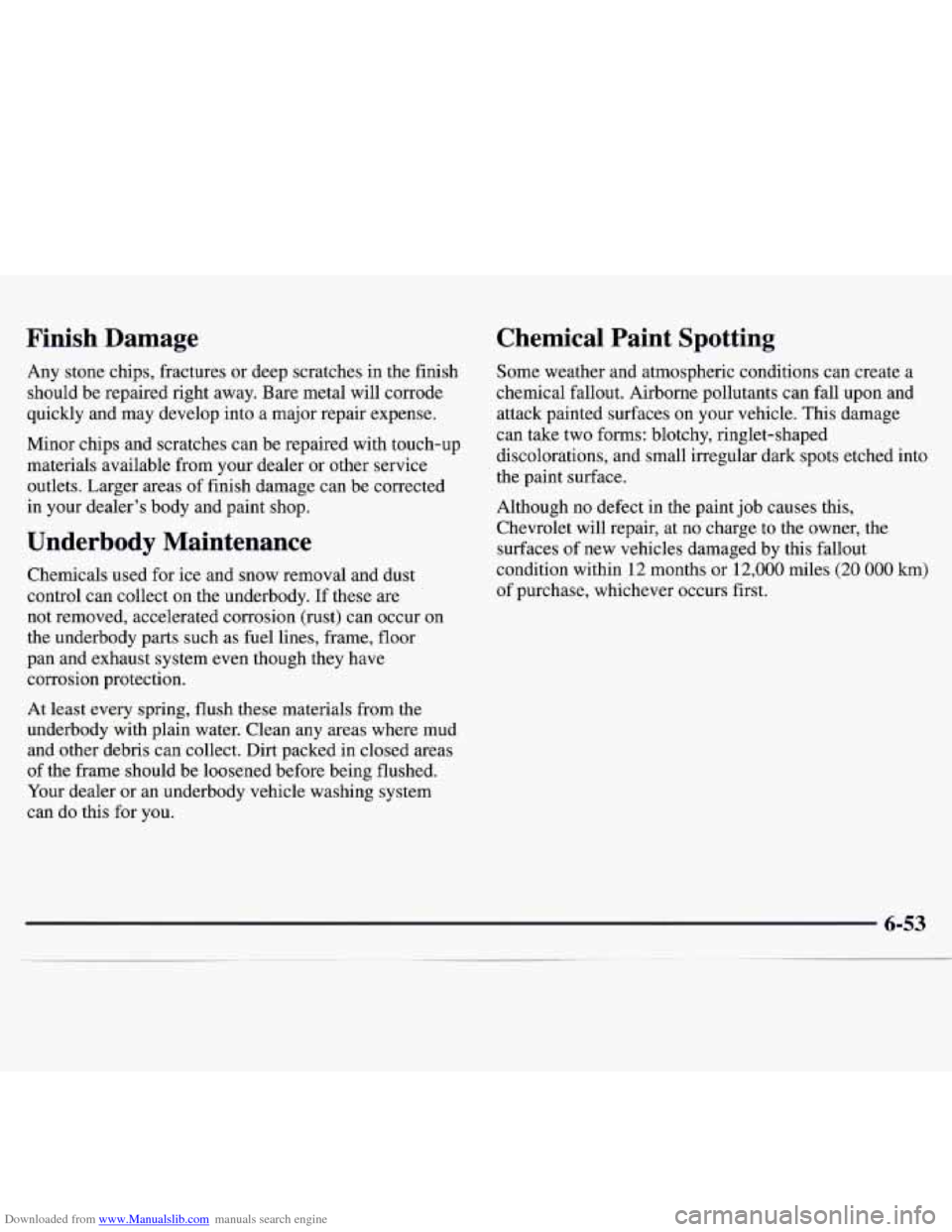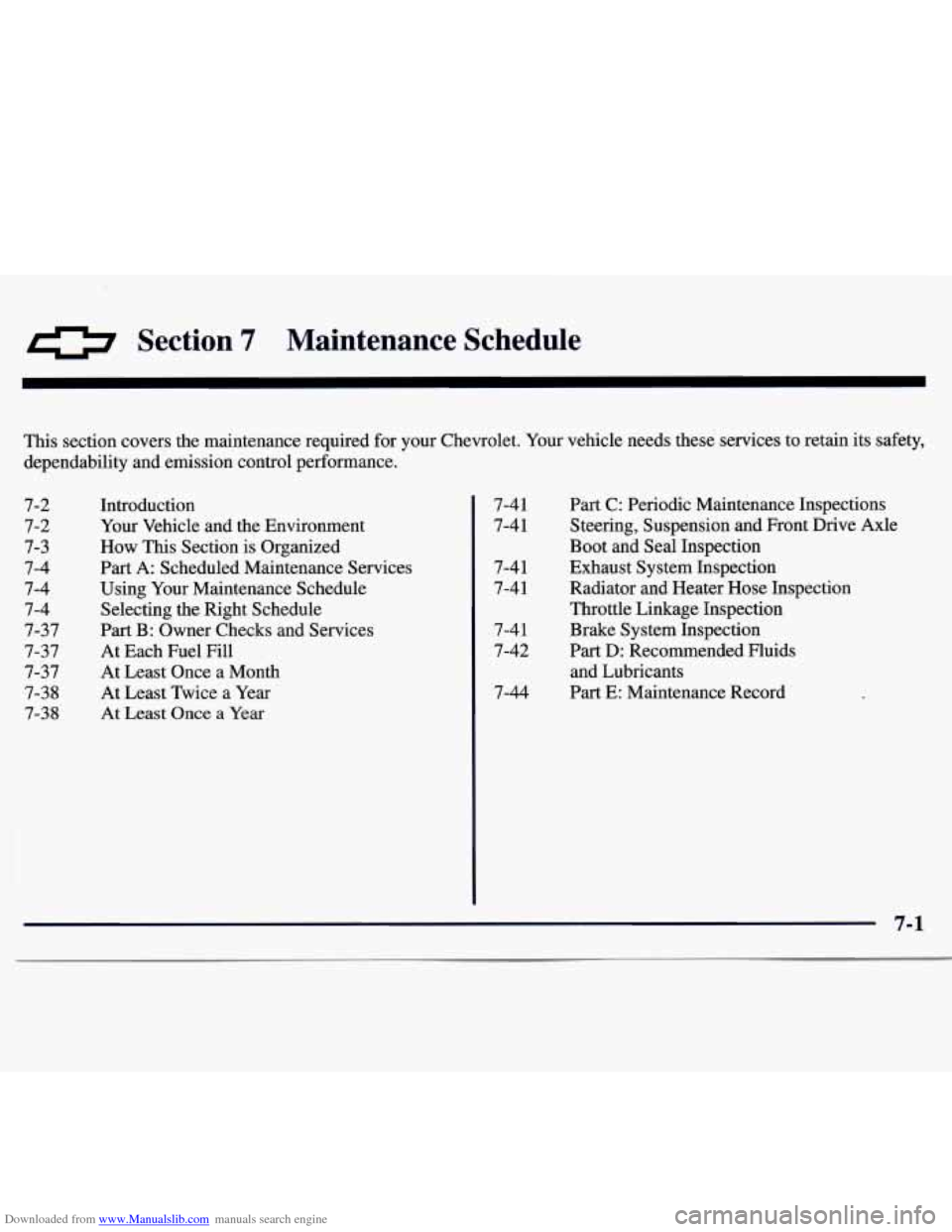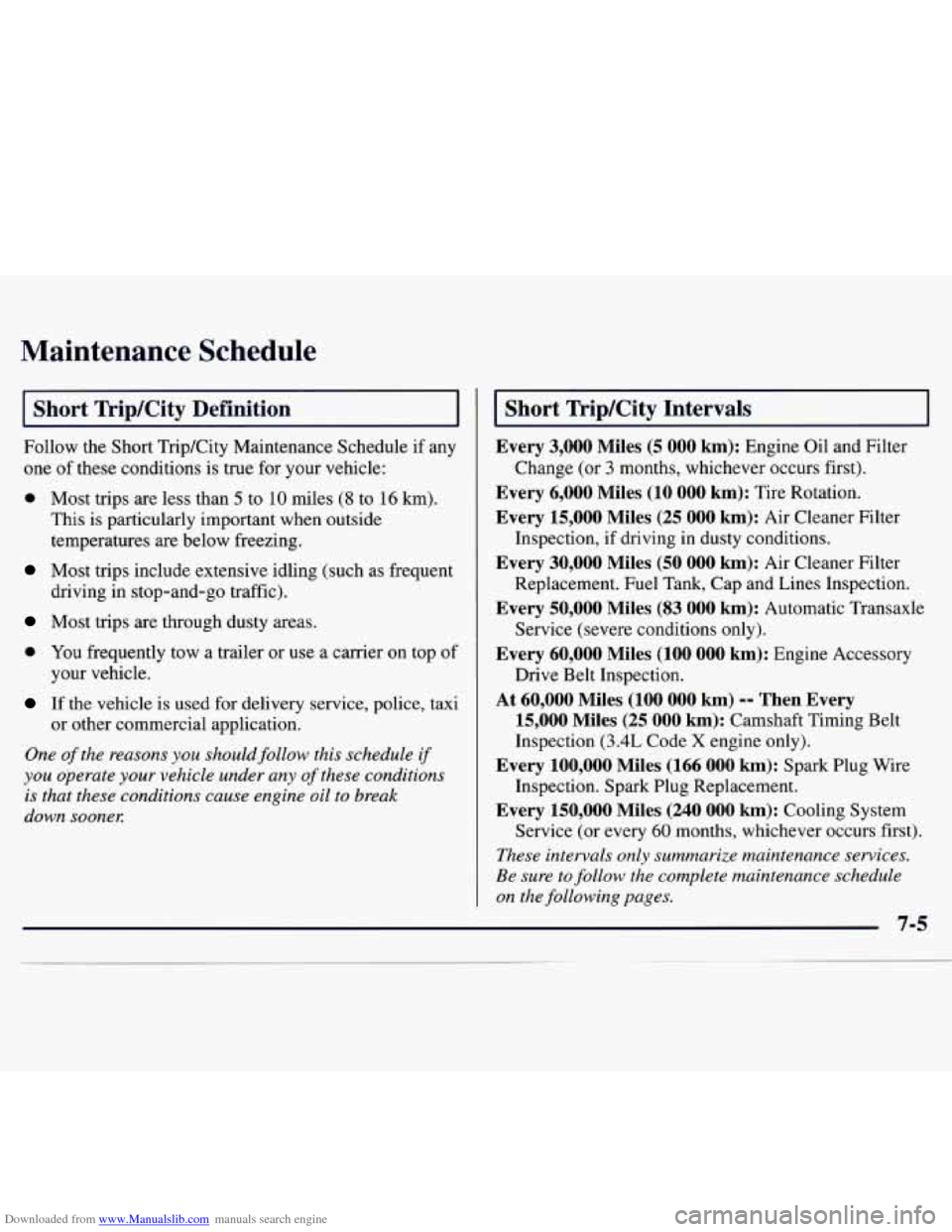1997 CHEVROLET MONTE CARLO fuel
[x] Cancel search: fuelPage 253 of 358

Downloaded from www.Manualslib.com manuals search engine Underinflated tires pose the same danger as
overloaded tires. The resulting accident
could cause serious injury. Check all tires
frequently
to maintain the recommended
pressure. Tire pressure should be checked
when your tires are cold.
Overinflated tires are more likely to be cut,
punctured or broken by
a sudden impact --
such as when you hit a pothole. Keep tires
at the recommended pressure.
Worn, old tires can cause accidents. If your
tread
is badly worn, or if your tires have
been damaged, replace them.
Inflation -- Tire Pressure
The Tire-Loading Information label, which is on the
inside
of the trunk lid shows the correct inflation
pressures
for your tires when they’re cold. “Cold”
means your vehicle has been sitting for at least three
hours or driven no more than 1 mile (1.6 km).
NOTICE:
Don’t let anyone tell you that underinflation or
overinflation is all right.
It’s not. If your tires
don’t have enough air (underinflation), you can
get the following:
Too much flexing
Too much heat
Tire overloading
Bad wear
Bad handling
Bad fuel economy.
If your tires have too much air (overinflation),
you can get the following:
0 Unusual wear
0 Bad handling
0 Rough ride
0 Needless damage from road hazards.
6-38
Page 268 of 358

Downloaded from www.Manualslib.com manuals search engine Finish Damage
Any stone chips, fractures or deep scratches in the finish
should be repaired right away. Bare metal will corrode
quickly and may develop into a major repair expense.
Minor chips and scratches can be repaired with touch-up
materials available from your dealer or other service
outlets. Larger areas
of finish damage can be corrected
in your dealer’s body and paint shop.
Underbody Maintenance
Chemicals used for ice and snow removal and dust
control can collect
on the underbody. If these are
not removed, accelerated corrosion (rust) can occur on
the underbody parts such as fuel lines, frame, floor
pan and exhaust system even though they have
corrosion protection.
At least every spring, flush these materials from
the
underbody with plain water. Clean any areas where mud
and other debris can collect. Dirt packed in closed areas
of the frame should be loosened before being flushed.
Your dealer or an underbody vehicle washing system
can do this for you.
Chemical Paint Spotting
Some weather and atmospheric conditions can create a
chemical fallout. Airborne pollutants can fall upon and
attack painted surfaces on your vehicle. This damage
can take two forms: blotchy, ringlet-shaped
discolorations, and small irregular dark spots etched into
the paint surface.
Although no defect in the paint job causes this,
Chevrolet will repair, at no charge to the owner, the
surfaces of new vehicles damaged by this fallout
condition within
12 months or 12,000 miles (20 000 km)
of purchase, whichever occurs first.
Page 275 of 358

Downloaded from www.Manualslib.com manuals search engine Underhood Electrical Center -- Passenger’s Side
Some fuses are in a fuse block on the passenger’s side of
the engine compartment. uuu R/CMPT REL PCM BAT
000 A/C CONT TRANS
FANJN PCM IGN ELEK IGN
--
I 14 11 15 I
1.I 1 1 11
000
000
A/C CONT TRANS
FANJN PCM IGN ELEK IGN
1
Fuse
R/CMPT REL
PCM BAT
TRANS NC CONT
Description
Remote Trunk Release
Powertrain Control Module
(PCM), Fuel Pump/Oil Pressure
Switch,
Fuel Pump Relay, Fan
Cont
#I and #2 Relay
Automatic Transaxle, Transaxle
Range Switch (VIN
M only)
A/C CMPR Relay (VIN
M Only)
Page 276 of 358

Downloaded from www.Manualslib.com manuals search engine Fuse
F/INJN PCM IGN
ELEK IGN
10
12
13
Relay
14
15
16
17
18
Description
Fuel Injectors
Powertrain Control Module
(PCM),
Mass Air Flow (MAF) Sensor (VIN
X only), EGR, CCP, Oxygen Sensor,
Vacuum Canister Switch
Electronic Ignition
(EI)
Control Module
I/P Fuse Block
Passenger’s Side Underhood
Electrical Center, FRMP Relay,
Cooling Fans
#1 and #2, Ignition
Relay, P/N Switch
FAN CONT
#1 Relay, Circuit
Breaker
D
Description
FUEL PUMP
A/C CMPR
FAN CONT
#2 -- Secondary
Cooling Fan (Passenger’s Side)
FAN CONT
#1 -- Primary
Cooling Fan (Driver’s Side)
Ignition Relay
Underhood Electrical Center -9 Driver’s Side
Additional fuses are in a fuse block on the driver’s side
of the engine compartment.
Page 278 of 358

Downloaded from www.Manualslib.com manuals search engine Replacement Bulbs
Exterior Lamps Bulb Number
Back-up ......................... 3 156 or 3057
Center High-Mounted Stop
............... 891T2
Front ParkingiTurn Signal
............... 3357NA
Headlamp, High-Beam
................... 9005
Headlamp, Low-Beam
.................... 9006
Sidemarker, Front
......................... 194
Sidemarker, Rear
......................... 194
Stop/Tail/Turn Signal
..................... 3057
Interior Lamps Bulb Number
Dome ............................. 10230955
*For service information
on these bulbs, contact your
Chevrolet dealer service department.
Capacities and Specifications
Please refer to “Recommended Fluids and Lubricants”
in
the Index for more information.
Automatic Transaxle
Pan Removal and Replacement ..... 7 quarts (6.7 L)
After Complete Overhaul
......... 10 quarts (9.5 L)
When drainingh-eplucing convertel; more fluid muy
be needed.
Cooling System Including Reservoir
3100 (Code M) .............. 11.6 quarts (10.94 L)
3.4L DOHC (Code
X) ........ 12.3 quarts (1 1.65 L)
Refrigerant (R-l34a),
Air Conditioning* ....... 1.88 pounds (0.85 kg)
Engine Crankcase - Oil and Filter Change
3100 (Code M) ................ 4.5 quarts (4.2 L)
3.4L DOHC (Code
X) .......... 5.5 quarts (5.2 L)
Windshield Wiper Blade Replacement
Length .................... 22 inches (559 mm)
Type
.................................. hook
Fuel Tank
3100 (Code M) .............. 16.6 gallons (62.8 L)
3.4L DOHC (Code
X) ........ 16.6 gallons (62.8 L)
*See “Air Conditioning Refrigerants” later in this section.
Note: All capacities are approximate. When adding,
be sure to
Jill to the approximate level, as
recommended in this manual. See “Recommended
Fluids and Lubricants” in the Index.
Page 282 of 358

Downloaded from www.Manualslib.com manuals search engine Section 7 Maintenance Schedule
This section covers the maintenance required for your Chevrolet. Your vehicle needs these services to retain its safety,
dependability and emission control performance.
7-2
7-2 7-3
7-4
7-4
7-4
7-37
7-37
7-37 7-38
7-38
Introduction
Your Vehicle and the Environment
How This Section is Organized
Part A: Scheduled Maintenance Services
Using Your Maintenance Schedule
Selecting the Right Schedule
Part B: Owner Checks and Services
At Each Fuel
Fill
At Least Once a Month
At Least Twice a Year
At Least Once
a Year
7-41
7-41
7-4
1
7-4 1
7-4 1
7-42
7-44
Part C: Periodic Maintenance Inspections
Steering, Suspension and Front Drive
Axle
Boot and Seal Inspection
Exhaust System Inspection
Radiator and Heater Hose Inspection
Throttle Linkage Inspection
Brake System Inspection
Part D: Recommended Fluids
and Lubricants
Part E: Maintenance Record
7-1
Page 285 of 358

Downloaded from www.Manualslib.com manuals search engine Part A: Scheduled Maintenance
Services
Using Your Maintenance Schedule
We at General Motors want to help you keep your
vehicle in good working condition. But we don’t know
exactly how you’ll drive it. You may drive very short
distances only a few times a week. Or you may
drive
long distances all the time in very hot, dusty weather.
You may use your vehicle in making deliveries. Or
you may drive it to work, to do errands or in many
other ways.
Because
of all the different ways people use their GM
vehicles, maintenance needs vary. You may even need
more frequent checks and replacements than you’ll find
in the schedules in this section.
So please read this
section and note how you drive. If you have any
questions on how to keep your vehicle
in good
condition, see your Chevrolet dealer.
This part tells you the maintenance services you should
have done and when you should schedule them. If you
go to your dealer for your service needs, you’ll know
that GM-trained and supported service people will
perform the work using genuine
GM parts. The proper fluids and lubricants
to use are listed in Part D.
Make sure whoever services your vehicle uses these. All
parts should be replaced and all necessary repairs done
before you or anyone else drives the vehicle.
These schedules are for vehicles
that:
carry passengers and cargo within recommended
limits. You will find
these limits on your vehicle’s
Tire-Loading Information label. See “Loading Your
Vehicle” in the Index.
are driven on reasonable road surfaces within legal
driving limits.
0 use the recommended fuel. See “Fuel” in the Index.
Selecting the Right Schedule
First you’ll need to decide which of the two schedules is
right for your vehicle. Here’s how to decide which
schedule to follow:
7-4
.__
Page 286 of 358

Downloaded from www.Manualslib.com manuals search engine Maintenance Schedule
I Short Trip/City Definition
Follow the Short Trip/City Maintenance Schedule if any
one
of these conditions is true for your vehicle:
0 Most trips are less than 5 to 10 miles (8 to 16 km).
This is particularly important when outside
temperatures are below freezing.
driving in stop-and-go traffic).
Most trips include extensive idling (such as frequent
Most trips are through dusty areas.
0 You frequently tow a trailer or use a carrier on top of
If the vehicle is used for delivery service, police, taxi
your vehicle.
or other commercial application.
One
of the reasons you should follow this schedule if
you operate your vehicle under any of these conditions
is that these conditions cause engine oil to break
down soonel:
Short Trip/City Intervals
Every 3,000 Miles (5 000 km): Engine Oil and Filter
Change (or
3 months, whichever occurs first).
Every 6,000 Miles (10 000 km): Tire Rotation.
Every 15,000 Miles (25 000 km): Air Cleaner Filter
Inspection,
if driving in dusty conditions.
Every 30,000 Miles (50 000 km): Air Cleaner Filter
Replacement. Fuel Tank, Cap and Lines Inspection.
Every 50,000 Miles (83 000 km): Automatic Transaxle
Service (severe conditions only).
Every 60,000 Miles (100 000 km): Engine Accessory
Drive Belt Inspection.
At 60,000 Miles (100 000 km) -- Then Every
15,000 Miles
(25 000 km): Camshaft Timing Belt
Inspection
(3.4L Code X engine only).
Every 100,000 Miles (166 000 km): Spark Plug Wire
Inspection. Spark Plug Replacement.
Every 150,000 Miles (240 000 km): Cooling System
Service (or every
60 months, whichever occurs first).
These intervals only summarize maintenance services.
Be sure to
follow the complete maintenance schedule
on the following pages.